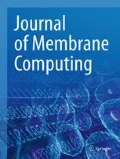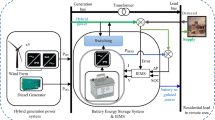Abstract
To achieve carbon peaking and carbon neutrality goals, the research on technologies related to the grid connection of high proportion renewable energy has become a hot spot. Multi-microgrid is a feasible solution, only by ensuring the safe and stable operation of the multi-microgrid system can the advantages of the multi-microgrid be brought into full play. Different from other membrane systems, spiking neural dP systems can solve input problems in a distributed manner, making it suitable for the control field. First, to ensure the stable operation of the multi-microgrid, this paper introduces the fuzzy theory into the spiking neural dP systems and proposes fuzzy spiking neural dP systems (FSNdPS). The improved P system can better solve the problems of uncertainty and inaccuracy contained in the multi-microgrid information caused by the high proportion of new energy access. Second, the proposed FSNdPS are used to model the coordinated control of a typical multi-microgrid structure, and the corresponding coordinated control strategy is proposed. Finally, the correctness and feasibility of the proposed method are verified by a reasoning test and MATLAB simulation, and the safe and stable operation of multi-microgrid is realized.












Similar content being viewed by others
Data availability
The data that support the findings of this study are available from the corresponding author upon reasonable request.
References
Păun, G. (2000). Computing with membranes. Journal of Computer and System Sciences, 61(1), 108–143.
Zhang, G., Prez-Jimnez, M. J., Riscos-Nñez, A., et al. (2021). Membrane computing models: Implementations. Springer.
Dong, J., Zhang, G., Luo, B., et al. (2022). A distributed adaptive optimization spiking neural P system for approximately solving combinatorial optimization problems. Information Sciences, 596, 1–14.
Zhang, G., Zhang, X., Rong, H., et al. (2022). A layered spiking neural system for classification problems. International Journal of Neural Systems, 32(08).
Wang, T., Zhang, G., & Pérez-Jiménez, M. J. (2015). Fuzzy membrane computing: Theory and applications. International Journal of Computers Communications & Control, 10(6), 861–892.
Rong, H., Duan, Y., & Zhang, G. (2022). A bibliometric analysis of membrane computing (1998–2019). Journal of Membrane Computing, 4(2), 177–207.
Huang, Y., Wang, T., Wang, J., et al. (2021). Reliability evaluation of distribution network based on fuzzy spiking neural P system with self-synapse. Journal of Membrane Computing, 3(1), 51–62.
Zhao, Y., Zhang, W., Sun, M., et al. (2020). An improved consensus clustering algorithm based on cell-like P systems with multi-catalysts. IEEE Access, 8, 154502–154517.
Peng, H., Wang, J., Shi, P., et al. (2017). Fault diagnosis of power systems using fuzzy tissue-like P systems. Integrated Computer Aided Engineering, 24(4), 401–411.
Wang, T., Wei, X., Wang, J., et al. (2020). A weighted corrective fuzzy reasoning spiking neural P system for fault diagnosis in power systems with variable topologies. Engineering Applications of Artificial Intelligence, 92.
Liu, W., Wang, T., Zang, T., et al. (2020). A fault diagnosis method for power transmission networks based on spiking neural P systems with self-updating rules considering biological apoptosis mechanism. Complexity, 2020(2), 1–18.
Wang, T., Liu, W., Cabrera, L. V., et al. (2022). A novel fault diagnosis method of smart grids based on memory spiking neural P systems considering measurement tampering attacks. Information Sciences, 596, 520–536.
Huang, Z., Wang, T., Liu, W., et al. (2021). A fault analysis method for three-phase induction motors based on spiking neural P systems. Complexity, 2021(4), 1–19.
Yu, W., Wang, J., Peng, H., et al. (2017). Fault diagnosis of power systems using fuzzy reasoning spiking neural P systems with interval-valued fuzzy numbers. Romanian Journal of Information Science and Technology, 20(1), 5–17.
Tao, C., Yu, W., Wang, J., et al. (2016). Fault diagnosis of power systems based on triangular fuzzy spiking neural P systems. In Bio-inspired computing—Theories and applications (vol. 681, pp. 385–398). Springer, Singapore.
Peng, H., Wang, J., Ming, J., et al. (2018). Fault diagnosis of power systems using intuitionistic fuzzy spiking neural P systems. IEEE Transactions on Smart Grid, 9(5), 4777–4784.
Wang, J., Peng, H., Yu, W., et al. (2019). Interval-valued fuzzy spiking neural P systems for fault diagnosis of power transmission networks. Engineering Applications of Artificial Intelligence, 82(6), 102–109.
Păun, G., & Pérez-Jiménez, M. J. (2010). Solving problems in a distributed way in membrane computing: dP systems. International Journal of Computers Communications & Control, 5(2), 238–250.
Ionescu, M., Pérez-Jiménez, M. J., Păun, G., et al. (2011). Spiking neural dP systems. Fundamenta Informaticae, 111(4), 423–436.
Cabarle, F. G. C., & Adorna, H. N. (2012). Some notes on spiking neural dP systems and Petri nets. Springer.
Buno, K. C., Cabarle, F. G. C., Calabia, M. D., et al. (2018). Solving the N-queens problem using dP systems with active membranes. Theoretical Computer Science, 736, 1–14.
Yu, W., Wang, J., Tao, W., et al. (2017). Distributed fuzzy P systems with promoters and their application in power balance of multi-microgrids. In International conference on bio-inspired computing: Theories and applications (vol. 791, pp. 329–342). Springer.
Zhang, G., Rong, H., Paul, P., et al. (2020). A complete arithmetic calculator constructed from spiking neural P systems and its application to information fusion. International Journal of Neural Systems, 31(1), 1–17.
Zhu, M., Yang, Q., Dong, J., et al. (2021). An adaptive optimization spiking neural P system for binary problems. International Journal of Neural Systems, 31(1).
Song, X., Valencia-Cabrera, L., Peng, H., et al. (2021). Spiking neural P systems with autapses. Information Sciences, 570(8), 383–402.
Vasiljevska, J., Lopes, J. A. P., & Matos, M. A. (2012). Evaluating the impacts of the multi-microgrid concept using multicriteria decision aid. Electric Power Systems Research, 91, 44–51.
Yang, K., Li, C., Jing, X., et al. (2022). Energy dispatch optimization of islanded multi-microgrids based on symbiotic organisms search and improved multi-agent consensus algorithm. Energy, 239, 122105.1–122105.17
Yang, D., Zhang, C., Jiang, C., et al. (2021). Interval method based optimal scheduling of regional multi-microgrids with uncertainties of renewable energy. IEEE Access, 9, 53292–53305.
Wang, C., Zhang, G., Chen, S., et al. (2021). Bilevel energy optimization for grid-connected AC multimicrogrids. International Journal of Electrical Power & Energy Systems, 130(1), 106934.1–106934.17.
Tang, W., & Qin, H. (2020). Multi-microgrid optimal scheduling considering electric vehicle participation. IEEE.
Acknowledgements
This work was partially supported by the Sichuan Key Laboratory Project of Artificial Intelligence (No. 2021RYY05), the Sichuan Provincial Engineering Laboratory Open Research Project (No. WRXT2021-005), the School-Level Projects of Chengdu Technological University (No. 2022ZR053 and no. 2022ZR054), and the Sichuan Undergraduate Innovation and Entrepreneurship Training Program (No. S202211116031).
Author information
Authors and Affiliations
Corresponding author
Additional information
Publisher's Note
Springer Nature remains neutral with regard to jurisdictional claims in published maps and institutional affiliations.
Rights and permissions
Springer Nature or its licensor (e.g. a society or other partner) holds exclusive rights to this article under a publishing agreement with the author(s) or other rightsholder(s); author self-archiving of the accepted manuscript version of this article is solely governed by the terms of such publishing agreement and applicable law.
About this article
Cite this article
Yu, W., Xiao, X., Wu, J. et al. Application of fuzzy spiking neural dP systems in energy coordinated control of multi-microgrid. J Membr Comput 5, 69–80 (2023). https://doi.org/10.1007/s41965-023-00118-9
Received:
Accepted:
Published:
Issue Date:
DOI: https://doi.org/10.1007/s41965-023-00118-9




